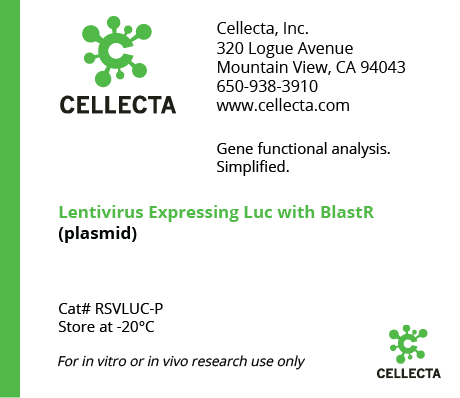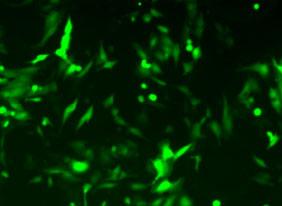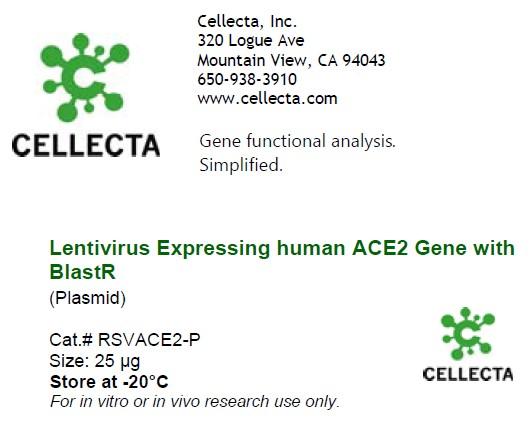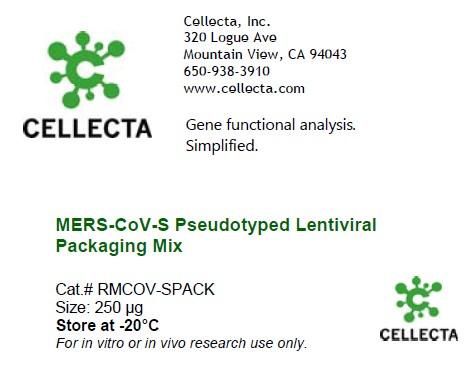Cellecta offers a range of products and services to support research on coronavirus. The public health crisis resulting from the current COVID-19 pandemic has made clear the critical need to improve understanding of pathogenic viruses, in particular, coronaviruses. Three deadly outbreaks since the early 2000s were due to different species of this viral group, with the latest SAR2-CoV2 virus resulting in hundreds of thousands of deaths worldwide.
Lentiviral particles which are routinely used in biosafety level-2 (BSL-2) laboratories, can be pseudotyped with coronavirus spike proteins (S-protein) that mediate binding and infection to target cells. The spike protein on the viral surface binds to the cellular receptor allowing the virus to enter the cell.
The use of actual coronavirus for testing infection requires BSL-3 or higher laboratory procedures, which limits the ability to do this research. However, lentiviral particles can be manipulated in typical BSL-2 laboratories. Pseudotyping the lentiviral particles with the coronavirus coat protein, such as spike protein, enables researchers to study binding using routine laboratory procedures. As a result, it is possible to conveniently investigate how compounds, factors, and other parameters might inhibit or otherwise affect coronavirus-cell interactions, enabling a larger number of investigators to carry out studies that help better understand the biology of these viruses.
-
Coronaviruses enter cells using the spike glycoprotein (or S-protein) present on the surface of the virus. Antibodies that neutralize infection of the virus often inhibit or otherwise block binding of the spike protein with its receptor on the target cells (e.g., the Ace2 protein). As a result, there is significant interest in studying this interaction using assays to measure how antibodies and other compounds or factors affect viral binding and entry.
Since SARS and MERS coronaviruses are pathogenic, research on them requires biosafety level-3 procedures which can be difficult to carry out in most commercial and university laboratories. An alternative approach is to pseudotype lentiviral particles with the coronavirus coat proteins. This enables researchers to carry out studies on these viral elements in BSL-2 environments. Cellecta offers a range of products to enable laboratories to carry out studies using these spike-protein pseudotyped lentiviral particles.
-
Spike-protein-pseudotyped lentiviral particles with fluorescent protein or luciferase reporters for a number of variants including alpha, beta, gamma, delta and omicron.
-
Cell lines engineered to express the receptor protein binding target (i.e., Ace2 for SARS-CoV and SARS-CoV2 and Dpp4 for MERS-Cov).
-
Packaged lentivirus expressing the receptor protein binding target to make your own response cell lines for the binding assay.
- Pseudotyped Lentiviral Packaging Mixes

-
Making spike-protein pseudotyped lentivirus follows the same basic protocol as making the standard VSV-G pseudotyped lentiviral particle. Transduce 293T cells with the following:
- A lentiviral reporter vector which carries the fluorescent protein or luciferase reporter with a lentiviral backbone plasmid encoding a fluorescent or luminescent reporter protein.
- A plasmid expressing the Spike protein.
- The packaging plasmids expressing the minimal set of lentiviral proteins required to assemble viral particles (i.e., Gag, Pol, and Rev).
The cells are then incubated for 2 days and subsequently, the pseudotyped viral particles are harvested from the cellular supernatant.
Once made, the Spike-pseudotyped viral particles will infect cells that express the appropriate receptor protein, either Ace2 for the SARS-CoV and SARS-CoV2, or Dpp4 for MERS-CoV.
-
While next-generation sequencing technologies have been used to discover thousands of animal-derived viruses, little is understood regarding the potential pathology of these viruses. Due to biosafety concerns, research on the biology of these viruses is difficult and slow. Lentiviral pseudotyping provides a scalable biosafety level 2-compatible (BSL-2) method to at least test the key elements required for interacting with host receptors. All that is needed to make these reagents is sequence information. Cellecta hopes wider availability of reagents such as these will accelerate critical research to enhance understanding of the biology of these viruses by facilitating studies such as:
- Screening compounds, antibodies, or other factors for inhibition or agonistic effects on Spike protein binding.
- Testing how mutational variants of the Spike Protein change binding efficacy.
- Similar approaches may be used for identifying receptors or otherwise characterizing binding and potential pathogenicity of novel coronaviruses.

-
Products














